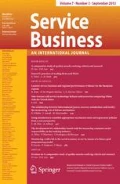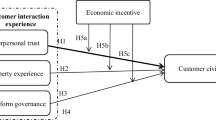Abstract
This study applies the resource exchange theory and social exchange theory perspectives in examining the structural relationships among value-creating components, trusting beliefs, and platform loyalty. An online survey (N = 320) was implemented to collect data from American respondents. Structural equation modeling analysis was conducted to test the proposed hypotheses. Results showed that the value-creating components of platform quality, compatibility, market opportunity, and fairness except for convenience had significant positive effects on trusting beliefs. Trusting beliefs positively influenced both switching resistance loyalty. Subsequently, switching resistance loyalty positively influenced loyalty to the platform. Theoretical and practical implications of the results are discussed.

Similar content being viewed by others
References
Alqahtani FA (2014) A fair exchange & customer anonymity protocol using a trusted third party for electronic commerce transactions & payments. Int J Netw Secur Appl 6(1):59–74
Anderson JC, Gerbing DW (1988) Structural equation modeling in practice: a review and recommended two-step approach. Psychol Bull 103(3):411–423
Balasubramanian S, Konana P, Menon NM (2003) Customer satisfaction in virtual environments: a study of online investing. Manag Sci 49(7):871–889
Basole RC, Karla J (2011) On the evolution of mobile platform ecosystem structure and strategy. Bus Inf Syst Eng 3(5):313–322
Bentler PM, Mooijaart A (1989) Choice of structural model via parsimony: a rationale based on precision. Psychol Bull 106(2):315–317
Brinberg D, Wood R (1983) A resource exchange theory analysis of consumer behavior. J Consum Res 10(3):330–338
Casaló LV, Flavián C, Guinalíu M (2011) Understanding the intention to follow the advice obtained in an online travel community. Comput Hum Behav 27(2):622–633
Cazier J (2003) The role of value compatibility in trust production and e-commerce. AMCIS 2003 Proceedings 430
Ceccagnoli M, Forman C, Huang P, Wu DJ (2012) Cocreation of value in a platform ecosystem! the case of enterprise software. MIS Q 36(1):263–290
Chen CJ, Hung SW (2010) To give or to receive? Factors influencing members’ knowledge sharing and community promotion in professional virtual communities. Inf Manag 47(4):226–236
Chen D, Lai F, Lin Z (2014) A trust model for online peer-to-peer lending: a lender’s perspective. Inf Technol Manag 15(4):239–254
Collier JE, Kimes SE (2013) Only if it is convenient: understanding how convenience influences self-service technology evaluation. J Serv Res 16(1):39–51
Dann S (2008) Adaptation and adoption of the American Marketing Association (2007) definition for social marketing. Soc Mark Q 14(2):92–100
Das TK, Teng BS (2000) A resource-based theory of strategic alliances. J Manag 26(1):31–61
Delone WH, McLean ER (2003) The DeLone and McLean model of information systems success: a ten-year update. J Manag Inf Syst 19(4):9–30
Ert E, Fleischer A, Magen N (2016) Trust and reputation in the sharing economy: the role of personal photos in Airbnb. Tour Manag 55:62–73
Fernández-Sabiote E, Román S (2016) The multichannel customer’s service experience: building satisfaction and trust. Serv Bus 10(2):423–445
Flavián C, Guinalíu M, Gurrea R (2006) The role played by perceived usability, satisfaction and consumer trust on website loyalty. Inf Manag 43(1):1–14
Fornell C, Larcker DF (1981) Evaluating structural equation models with unobservable variables and measurement error. J Mark Res 18(1):39–50
Gefe D, Karahanna E, Straub DW (2003) Trust and TAM in online shopping: an integrated model. MIS Q 27(1):51–90
Ghezzi A, Nogueira Cortimiglia M, Balocco R (2012) Mobile content and service delivery platforms: a technology classification model. Info 14(2):72–88
Gruber M, MacMillan IC, Thompson JD (2008) Look before you leap: market opportunity identification in emerging technology firms. Manag Sci 54(9):1652–1665
Gupta R, Kabadayi S (2010) The relationship between trusting beliefs and web site loyalty: the moderating role of consumer motives and flow. Psychol Mark 27(2):166–185
Hair JF, Anderson RE, Tatham RL, Black WC (2010) Multivariate data analysis, 7th edn. Prentice-Hall Inc., Upper Saddle River
Heo CY (2016) Sharing economy and prospects in tourism research. Ann Tour Res 58:166–170
Hung K, Li SY, Tse DK (2011) Interpersonal trust and platform credibility in a Chinese multibrand online community. J Advert 40(3):99–112
Hwang J, Griffiths MA (2017) Share more, drive less: millennials value perception and behavioral intent in using collaborative consumption services. J Consum Mark 34(2):132–146
Jarach D (2002) The digitalisation of market relationships in the airline business: the impact and prospects of e-business. J Air Trans Manag 8(2):115–120
Jiang L, Jun M, Yang Z (2016) Customer-perceived value and loyalty: how do key service quality dimensions matter in the context of B2C e-commerce? Serv Bus 10(2):301–317
Johnson TJ, Kaye BK (2002) We believability: a path model examining how convenience and reliance predict online credibility. J Mass Commun Q 79(3):619–642
Jung H, Lee G, Hur K, Kim TT (2018) Online travel information value and its influence on the continuance usage intention of social media. Serv Bus 12(1):85–120
Karahanna E, Agarwal R, Angst CM (2006) Reconceptualizing compatibility beliefs in technology acceptance research. MIS Q 30(4):781–804
Karani KG, Fraccastoro KA (2010) Resistance to brand switching: the elderly consumer. J Bus Econ Res 8(12):77–83
Karayanni DA (2003) Web-shoppers and non-shoppers: compatibility, relative advantage and demographics. Eur Bus Rev 15(3):141–152
Kim HW, Gupta S (2012) Investigating customer resistance to change in transaction relationship with an Internet vendor. Psychol Mark 29(4):257–269
Kim TT, Karatepe OM, Lee G (2018) Test of an integrative model of travel-related social media users’ switching intentions. Serv Bus. https://doi.org/10.1007/s11628-018-0385-6
Komiak SY, Benbasat I (2006) The effects of personalization and familiarity on trust and adoption of recommendation agents. MIS Q 30(4):941–960
Lam SK, Ahearne M, Hu Y, Schillewaert N (2010) Resistance to brand switching when a radically new brand is introduced: a social identity theory perspective. J Mark 74(6):128–146
Lee D (2018) Effects of key value co-creation elements in the healthcare system: focusing on technology applications. Serv Bus. https://doi.org/10.1007/s11628-018-00388-9
Lee KH, Hyun SS (2016) A model of value-creating practices, trusting beliefs, and online tourist community behaviors: risk aversion as a moderating variable. Int J Contemp Hosp Manag 28(9):1868–1894
Lee JJ, Capella ML, Taylor CR, Gabler CB (2014) The financial impact of loyalty programs in the hotel industry: a social exchange theory perspective. J Bus Res 67(10):2139–2146
Lee SM, Kim NR, Hong SG (2017) Erratum to: key success factors for mobile app platform activation. Serv Bus 11(2):451–451
Lin HF (2011) An empirical investigation of mobile banking adoption: the effect of innovation attributes and knowledge-based trust. Int J Inf Manag 31(3):252–260
Lorenzo-Romero C, Constantinides E, Alarcón-del-Amo MDC (2013) Web aesthetics effects on user decisions: impact of exposure length on website quality perceptions and buying intentions. J Internet Commer 12(1):76–105
Lu Y, Zhao L, Wang B (2010) From virtual community members to C2C e-commerce buyers: trust in virtual communities and its effect on consumers’ purchase intention. Electron Commer Res Appl 9(4):346–360
Lu J, Wang L, Hayes LA (2012) How do technology readiness, platform functionality and trust influence C2C user satisfaction? J Electron Commer Res 13(1):50–69
Márof R, Mat N, Rashid U, Nasuredin J, Sanita F (2012) Store loyalty, retail satisfaction and competitive resistance towards purchase intentions. Am J Econ 2(4):69–72
Marsh HW, Hocevar D (1985) Application of confirmatory factor analysis to the study of self-concept: first-and higher order factor models and their invariance across groups. Psychol Bull 97(3):562–582
McIntyre DP, Srinivasan A (2017) Networks, platforms, and strategy: emerging views and next steps. Strateg Manag J 38(1):141–160
McKnight DH, Chervany NL (2001) What trust means in e-commerce customer relationships: an interdisciplinary conceptual typology. Int J Electron Commer 6(2):35–59
McKnight DH, Choudhury V, Kacmar C (2002) The impact of initial consumer trust on intentions to transact with a web site: a trust building model. J Strateg Inf Syst 11(3):297–323
Medina C, Rufín R, Rey M (2015) Mediating relationships in and satisfaction with online technologies: communications or features beyond expectations? Serv Bus 9(4):587–609
Milanova V, Maas P (2017) Sharing intangibles: uncovering individual motives for engagement in a sharing service setting. J Bus Res 75:159–171
N’Goala G (2007) Customer switching resistance (CSR): the effects of perceived equity, trust and relationship commitment. Int J Serv Ind Manag 18(5):510–533
Parguel B, Lunardo R, Benoit-Moreau F (2017) Sustainability of the sharing economy in question: when second-hand peer-to-peer platforms stimulate indulgent consumption. Technol Forecast Soc Chang 125:48–57
Peña AIP, Jamilena DMF, Molina MÁR (2017) The effects of perceived value on loyalty: the moderating effect of market orientation adoption. Serv Bus 11(1):93–116
Pezenka I, Weismayer C, Lalicic L (2017) Personality impacts on the participation in peer-to-peer (P2P) travel accommodation services. In: Information and Communication Technologies in Tourism 2017 Springer, Cham, pp 767–780
Priporas CV, Stylos N, Rahimi R, Vedanthachari L (2017) Unraveling the diverse nature of service quality in a sharing economy: a social exchange theory perspective of Airbnb accommodation. Int J Contemp Hosp Manag 29(9):2279–2301
Reichheld FF, Schefter P (2000) E-loyalty: your secret weapon on the web. Harv Bus Rev 78(4):105–113
Reitz AK, Zimmermann J, Hutteman R, Specht J, Neyer FJ (2014) How peers make a difference: the role of peer groups and peer relationships in personality development. Eur J Pers 28(3):279–288
Rindskopf D, Rose T (1988) Some theory and applications of confirmatory second-order factor analysis. Multivar Behav Res 23(1):51–67
Roschk H, Trabold W, Gelbrich K (2018) Insights from social resource theory for service business development. service business development. Springer Gabler, Wiesbaden, pp 41–58
Rosenbaum MS, Kelleher C, Friman M, Kristensson P, Scherer A (2017) Re-placing place in marketing: a resource-exchange place perspective. J Bus Res 79:281–289
Ryu MH, Kim J, Kim S (2014) Factors affecting application developers’ loyalty to mobile platforms. Comput Hum Behav 40:78–85
Schlosser AE, White TB, Lloyd SM (2006) Converting web site visitors into buyers: how web site investment increases consumer trusting beliefs and online purchase intentions. J Mark 70(2):133–148
Sindhav B, Holland J, Rodie AR, Adidam PT, Pol LG (2006) The impact of perceived fairness on satisfaction: are airport security measures fair? does it matter? J Mark Theory Pract 14(4):323–335
Teddlie C, Yu F (2007) Mixed methods sampling: a typology with examples. J Mixed Methods Res 1(1):77–100
Tiwana A, Bush A (2000) Peer-to-peer valuation as a mechanism for reinforcing active learning in virtual communities: actualizing social exchange theory. In: Proceedings of the 33rd Hawaii International Conference on System Sciences (CD-ROM), Hawaii, USA
Truss LT, Wu P, Saroop A, Sehgal SK (2006) Enterprise demand sensing in the automotive industry. J Bus Forecast 25(3):22–23
Tussyadiah IP (2016) Factors of satisfaction and intention to use peer-to-peer accommodation. Int J Hosp Manag 55:70–80
Wang W, Benbasat I (2007) Recommendation agents for electronic commerce: effects of explanation facilities on trusting beliefs. J Manag Inf Syst 23(4):217–246
Wang W, Benbasat I (2008) Attributions of trust in decision support technologies: a study of recommendation agents for e-commerce. J Manag Inf Syst 24(4):249–273
Xie K, Mao Z (2017) The impacts of quality and quantity attributes of Airbnb hosts on listing performance. Int J Contemp Hosp Manag 29(9):2240–2260
Yang SJ, Chen IY (2008) A social network-based system for supporting interactive collaboration in knowledge sharing over peer-to-peer network. Int J Hum Comput Stud 66(1):36–50
Yang Q, Pang C, Liu L, Yen DC, Tarn JM (2015) Exploring consumer perceived risk and trust for online payments: an empirical study in China’s younger generation. Comput Hum Behav 50:9–24
Zhao J, Lau RY, Zhang W, Zhang K, Chen X, Tang D (2016) Extracting and reasoning about implicit behavioral evidences for detecting fraudulent online transactions in e-commerce. Decis Support Syst 86:109–121
Author information
Authors and Affiliations
Corresponding author
Additional information
Publisher's Note
Springer Nature remains neutral with regard to jurisdictional claims in published maps and institutional affiliations.
Rights and permissions
About this article
Cite this article
Lee, KH., Kim, D. A peer-to-peer (P2P) platform business model: the case of Airbnb. Serv Bus 13, 647–669 (2019). https://doi.org/10.1007/s11628-019-00399-0
Received:
Accepted:
Published:
Issue Date:
DOI: https://doi.org/10.1007/s11628-019-00399-0




